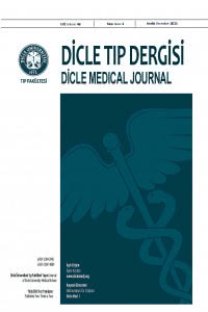Moleküler Hpv Uygulanan Olgularda Hpv Sonuçları ile Patolojik Materyallerin Karşılaştırılması
Comparison Of The Pathological Materials With Hpv Results In Patients With Molecular Hpv
___
- Aydoğdu SGM, Özsoy Ü. Serviks kanseri ve HPV. Androl Bul 2018; 20: 25−9.
- Saslow D, Solomon D, Lawson HW, et all. American Cancer Society, American Society for Colpos copy and Cervical Pathology, and American Society for Clinical Pathology Screening Guidelines for the Prevention and Early Detection of Cervical Cancer. CA Cancer J Clin 2012; 62: 147–72.
- Committee on Practice Bulletins—Gynecology. ACOG Practice Bulletin Number 131: Screening for cervical cancer. Obstet Gynecol 2012; 120: 1222–38.
- Eroğlu C, Keşli R, Eryılmaz MA, et all. Serviks kanseri için riski olan kadınlarda HPV tiplendirmesi ve HPV sıklığının risk faktörleri ve servikal smearle ilişkisi. Nobel Med 2011; 7: 72–7.
- Akay E, Tekelioglu F, Karaman H. Concordance of thefrequency, typing, andresults of high risk human papilloma virus in cervical cytology materials with biopsy: Retrospective analysis of 5604 patients. Annals of Medical Research 2019; 1: 1-5.
- T. C. Sağlık Bakanlığı Sağlık İstatistikleri Yıllığı 2015. Yayın No:1054. Ankara: Sistem Ofset Basım Yayın; 2016. ss.36–7.
- Altun E, Usta A, Bülbül ÇB, et al. HPV-DNA Alt Tiplerinin Smear ve Kolposkopik Biyopsi Sonuçlarının Korelasyonunun Değerlendirilmesi. Van Tıp Derg 2018; 25: 472-76.
- Huh WK, Ault KA, Chelmow D, et all. Use of primaryhigh-risk human papilloma virus testing for cervical cancer screening: interim clinical guidance. Obstet Gynecol 2015; 125: 330-37.
- Akcali S, Goker A, Ecemis T, et all. Human papilloma virus frequency and genotype distribution in a Turkish population. Asian Pac J Cancer Prev 2013; 14: 503-06.
- Dursun P, Ayhan A, Mutlu L, et all. HPV types in Turkey: multi center hospital based evaluation of 6388 patients in Turkish gynecologi concology group centers. Turk Patoloji Derg 2013; 29: 210-16.
- Bayram A, Derici YK, Yilmaz NO, et all. Prevalence of high–risk human papilloma virus in women from Turkey.Clin Obstet Gynecol Reprod Med 2015; 1: 84-6.
- Katki HA, Kinney WK, Fetterman B, et all. Cervical cancer risk for women undergoing concurrent testing for human papilloma virus and cervical cytology: a population-based study in routine clinical practice. Lancet Oncol 2011; 12: 663–72.
- ISSN: 1300-2945
- Yayın Aralığı: 4
- Başlangıç: 1963
- Yayıncı: Cahfer GÜLOĞLU
Narin GÜNDOĞUŞ, Kadri GÜL, Tuba DAL, NEZAHAT AKPOLAT
Aerochamber Eğitiminde Hangi Yöntem Daha Etkili?
Mehmet Yaşar ÖZKARS, Serkan KIRIK
Ciprofloxacin is not a better choice in the patients with diabetes suffering urinary tract infection
KADER UĞUR, İsa Ahmet BAL, AYŞE SAĞMAK TARTAR, NEVZAT GÖZEL, Bedrettin ORHAN, EMİR DÖNDER, Abdullah Mübin ÖZERCAN
Ratlarda Siklofosfamid ile İndüklenen Hepatotoksisite Üzerine Kuersetinin Etkileri
Effects of Breastfeeding and Perinatal Factors on Development of Retinopathy of Prematurity
Leyla CİMEN, Behzat CİMEN, Ihsan CETİN, Aysun CETİNYUREK--YAVUZ
Moleküler Hpv Uygulanan Olgularda Hpv Sonuçları ile Patolojik Materyallerin Karşılaştırılması
Türk kadınlarında görülen saç ve saçlı deri hastalıklarının değerlendirilmesi
Atiye OĞRUM, HAVVA YILDIZ SEÇKİN
